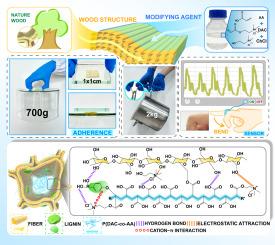粘胶导电木基水凝胶,具有高拉伸强度,可作为柔性传感器。
IF 12.5
1区 化学
Q1 CHEMISTRY, APPLIED
引用次数: 0
摘要
导电水凝胶在柔性应变传感器中有很好的应用前景。然而,大多数水凝胶的抗拉强度很差,容易损坏,这极大地阻碍了它们进一步应用的潜力。木材已被用来加强水凝胶,显著提高其强度和尺寸稳定性。然而,木基水凝胶通常缺乏粘合性能或表现出低自粘。为了解决这一问题,我们通过接枝聚集将丙烯酰氧乙基三甲基氯化铵(DAC)引入水凝胶网络。由此产生的静电相互作用显著增强了木基水凝胶的附着力,最高可达270千帕(对于玻璃),同时增强了其凝聚力。制备的新型木基水凝胶(WDDH)具有高抗拉强度(3.38 MPa)、低膨胀率(仅2%纵向)和高拉伸应变(274.40%)的特点。当使用WDDH作为可穿戴应变传感器时,其应变系数约为4.94。该设备有效地捕捉并检测人类的运动,包括手指和关节的弯曲、行走模式和饮水习惯。这项研究的目的是开发一种基于木材的水凝胶,它具有增强的机械强度、粘合性能和灵活性,可用于可穿戴传感器。这项研究为使用生物质材料开发具有改善粘附性能的柔性传感器水凝胶提供了见解。本文章由计算机程序翻译,如有差异,请以英文原文为准。

Adhesive conductive wood-based hydrogel with high tensile strength as a flexible sensor
Conductive hydrogels have promising applications for flexible strain sensors. However, most hydrogels have poor tensile strength and are susceptible to damage, significantly impeding their potential for further application. Wood has been used to reinforce hydrogels, significantly enhancing their strength and dimensional stability. However, wood-based hydrogels generally lack adhesive properties or exhibit low self-adhesion. To address this issue, we introduced acryloyloxyethyltrimethyl ammonium chloride (DAC) into the hydrogel network through graft aggregation. The resulting electrostatic interactions significantly enhanced the adhesion of the wood-based hydrogel up to 270 kPa (for glass) and concurrently strengthened its cohesion. The prepared novel wood-based hydrogel (WDDH) exhibited high tensile strength (3.38 MPa), low-swelling ratio (only 2 % longitudinal), and high tensile strain (274.40 %). When WDDH was used as the wearable strain sensor, it showed a gauge factor of approximately 4.94. The device effectively captured and detected human movements, including finger and joint flexion, walking patterns, and hydration habits. The objective of this research is to develop a wood-based hydrogel with enhanced mechanical strength, adhesive properties, and flexibility for use in wearable sensors. This study provides insight into the development of flexible sensor hydrogels with improved adhesion properties using biomass materials.
求助全文
通过发布文献求助,成功后即可免费获取论文全文。
去求助
来源期刊

Carbohydrate Polymers
化学-高分子科学
CiteScore
22.40
自引率
8.00%
发文量
1286
审稿时长
47 days
期刊介绍:
Carbohydrate Polymers stands as a prominent journal in the glycoscience field, dedicated to exploring and harnessing the potential of polysaccharides with applications spanning bioenergy, bioplastics, biomaterials, biorefining, chemistry, drug delivery, food, health, nanotechnology, packaging, paper, pharmaceuticals, medicine, oil recovery, textiles, tissue engineering, wood, and various aspects of glycoscience.
The journal emphasizes the central role of well-characterized carbohydrate polymers, highlighting their significance as the primary focus rather than a peripheral topic. Each paper must prominently feature at least one named carbohydrate polymer, evident in both citation and title, with a commitment to innovative research that advances scientific knowledge.
 求助内容:
求助内容: 应助结果提醒方式:
应助结果提醒方式:


